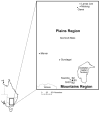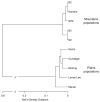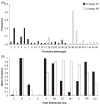Population structure and diversity in sexual and asexual populations of the pathogenic fungus Melampsora lini
- PMID: 18573166
- PMCID: PMC2653454
- DOI: 10.1111/j.1365-294X.2008.03843.x
Population structure and diversity in sexual and asexual populations of the pathogenic fungus Melampsora lini
Abstract
Many pathogens undergo both sexual and asexual reproduction to varying degrees, yet the ecological, genetic and evolutionary consequences of different reproductive strategies remain poorly understood. Here we investigate the population genetic structure of wild populations of the plant pathogen Melampsora lini on its host Linum marginale, using amplified fragment length polymorphism (AFLP) markers, two genes underlying pathogen virulence, and phenotypic variation in virulence. In Australia, M. lini occurs as two genetically and geographically divergent lineages (AA and AB), one of which is completely asexual (AB), and the other able to reproduce both clonally and sexually (AA). To quantify the genetic and evolutionary consequences of these different life histories, we sampled five populations in each of two biogeographical regions. Analysis of AFLP data obtained for 275 isolates revealed largely disjunct geographical distributions for the two different lineages, low genetic diversity within lineages, and strong genetic structure among populations within each region. We also detected significant divergence among populations for both Avr genes and virulence phenotypes, although generally these values were lower than those obtained with AFLP markers. Furthermore, isolates belonging to lineage AA collectively harboured significantly higher genotypic and phenotypic diversity than lineage AB isolates. Together these results illustrate the important roles of reproductive modes and geographical structure in the generation and maintenance of virulence diversity in populations of M. lini.
Figures





References
-
- Abdel-Muhsin AA, Mackinnon MJ, Awadalla P, et al. Local differentiation in Plasmodium falciparum drug resistance genes in Sudan. Parasitology. 2003;126:391–400. - PubMed
-
- Agapow PM, Burt A. Indices of multilocus linkage disequilibrium. Molecular Ecology Notes. 2001;1:101–102.
-
- Alexander HM, Antonovics J, Kelly AW. Genotypic variation in plant disease resistance — physiological resistance in relation to field disease transmission. Journal of Ecology. 1993;81:325–333.
-
- Anderson RM, May RM. Coevolution of hosts and parasites. Parasitology. 1982;85:411–426. - PubMed
-
- Anderson TJC, Nair S, Sudimack D, et al. Geographical distribution of selected and putatively neutral SNPs in Southeast Asian malaria parasites. Molecular Biology and Evolution. 2005;22:2362–2374. - PubMed
MeSH terms
Grants and funding
LinkOut - more resources
Full Text Sources

